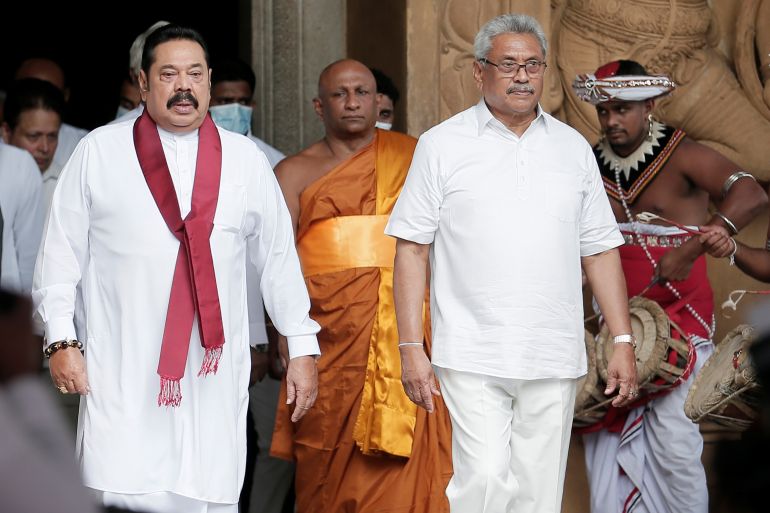In Sri Lanka, a prime minister is gone. What next?
Instead of addressing the financial and political crises, the administration has concentrated on consolidating its power.

Colombo, Sri Lanka – With the resignation of Mahinda Rajapksa, Sri Lanka’s prime minister and former two-time executive president, on Monday, many expect this is the beginning of the end of the dominance of Rajapaksas, one of the two most powerful political dynasties in post-independence Sri Lanka. The sitting president is the prime minister’s younger brother, Gotabaya.
But even if the Rajapaksas leave, the country’s financial and political crises are far from over.
Keep reading
list of 3 itemsDiplomats urge Sri Lanka to reconsider ‘state of emergency’
What’s the way out of Sri Lanka’s economic crisis?
Thousands of protesters have gathered daily in the heart of Colombo to hold peaceful protests demanding the resignation of President Gotabaya Rajapaksa and his government as the country’s economy continues its sharp nosedive.
On Monday, Rajapaksa loyalists attacked protesters in their camps and violence spiralled throughout the city and beyond, resulting in at least five people dead.
In response, the government announced an island-wide curfew and deployed the army.
The protesters are angered by the country’s economic collapse that has resulted in a severe shortage of the most essential goods. Over the past four months, queues for fuel and gas have gotten longer while hospitals ran out of medical supplies and markets emptied of food.
The protesters have held the Rajapaksas responsible for their current suffering and are demanding that they step away from the leadership.
Sri Lanka’s foreign reserves have plummeted and multilateral donor agencies have not been as supportive as the government hoped, including the International Monetary Fund (IMF) which did not offer a bailout.
Sri Lanka defaulted on its foreign debt of $51bn last month.
On May 3, a no-confidence motion was submitted in parliament against the Rajapaksa administration, and it seems to have shaken the family’s confidence. Last week, President Gotabaya Rajapaksa was believed to have asked his brother to step down to calm the political crisis.
In the meantime, the administration has announced plans to name a new prime minister to form an interim government. The public, however, has strongly rejected this and intensified their calls for the resignation of both the president and prime minister.
A popular politician
Mahinda Rajapaksa is a familiar face in Sri Lankan politics. During his first presidency, he was credited for ending the protracted war against the Liberation Tigers of Tamil Eelam, who fought to carve out a separate homeland in the island’s northeast.
But several rounds of corruption allegations against him have tarnished his reputation, and protesters say this is a major reason for the country’s economic crisis. Many refer to the Rajapaksas as the “Marcos family” of Sri Lanka.
After the 2004 Indian Ocean tsunami, the Rajapaksa administration was accused of siphoning off funds meant for the affected population. Large-scale corruption allegations were also levelled against the regime over military purchases during the civil war that ended in 2009.
Even his war victory is seen by many as having seriously divided the nation along ethnic lines and is tainted by charges of gross human rights violations.
Mahinda Rajapaksa’s first administration (from 2005 to 2010) was accused of committing crimes against humanity during the final phase of the civil war in May 2009, during which the UN estimated about 40,000 Tamil civilians died.
Political career
The 76-year-old veteran politician was first elected to office at the age of 24 in 1970 as the parliamentary representative of his father’s electorate Beliatta. He was defeated in 1977 but managed to return to parliament in 1989.
He became the island’s prime minister for the first time in 2004, winning by a small margin of less than 200,000 votes against rival Ranil Wickremesinghe, and a year later, was elected the fifth executive president of the country and continued in office for two terms until his surprise defeat in 2015 to his former party secretary Maithripala Sirisena.
He remained in politics, as leader of the opposition between 2018 and 2019, after which he became finance minister from 2019 to 2021. In 2021, his brother Basil Rajapaksa was appointed to the powerful finance portfolio by their brother Gotabaya who has been president of Sri Lanka since 2019. Basil Rajapaksa resigned a month ago amid the widespread popular anger.
“This is what happens when love turns into hate. Mahinda was a much-loved politician for long, respected and trusted, despite the many questions about his extensive personal wealth that does not tally with his lifestyle before 2005.
“There is a time to come and a time to go. When they don’t leave, people will force them to go,” said Aruna Nishantha, an anti-Rajapaksa protester.